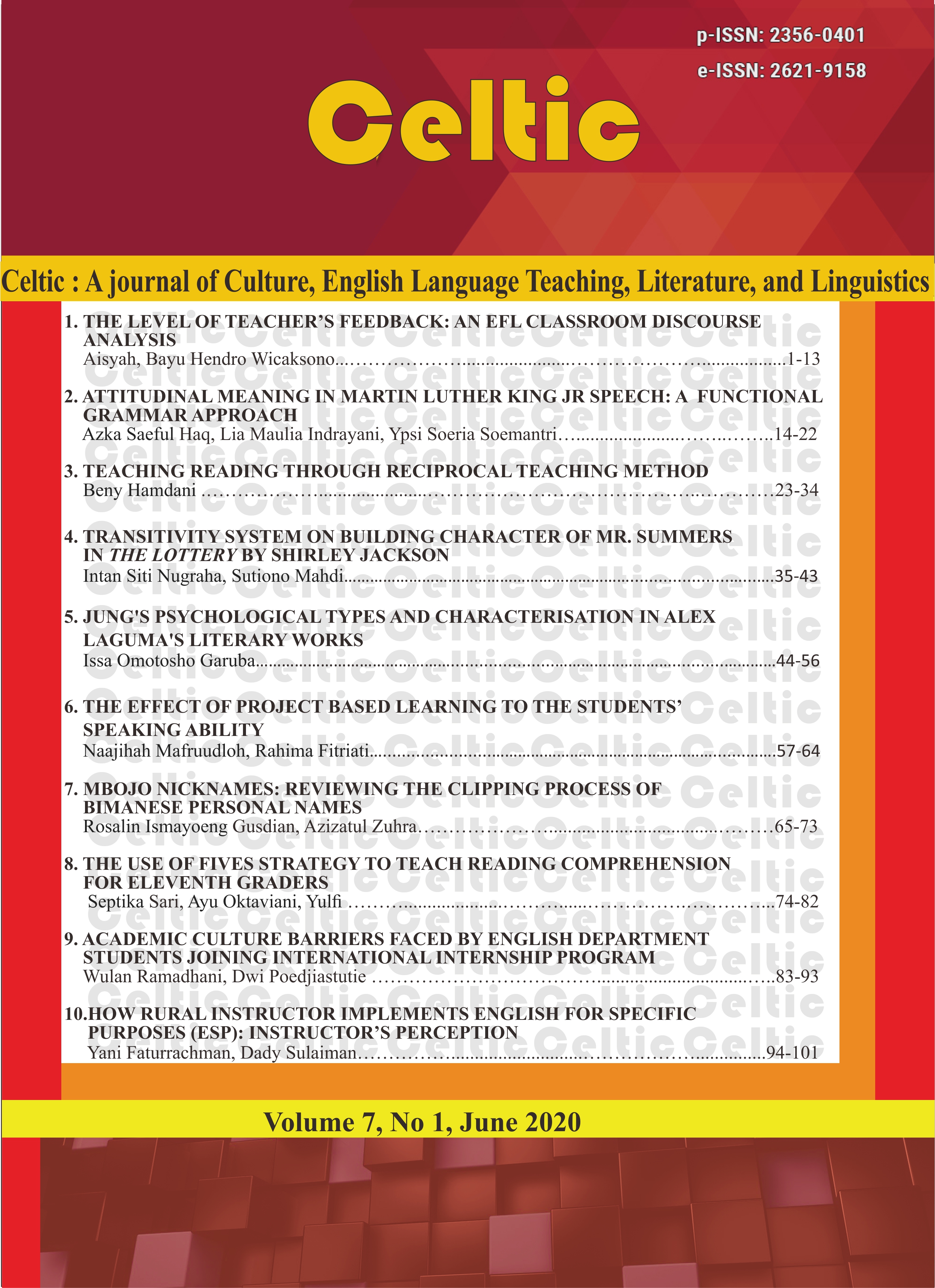TRANSITIVITY SYSTEM ON BUILDING CHARACTER OF MR. SUMMERS IN THE LOTTERY BY SHIRLEY JACKSON
DOI:
https://doi.org/10.22219/celtic.v7i1.11980Keywords:
Building character, Short story, Transitivity system.Abstract
The Lottery is one of the most famous American canonicals written by Shirley Jackson (1948) which is sensational. The theme brought triggers controversy to contemporary critics. The story exposed one of the darkest dualities of human nature in ‘the lottery’ carried out by the society in the story. The controversial character in the Lottery which evokes social culture issue is analyzed by investigating the process types related to the character. Types of process are essential in the building characters or characterization. Thus, this study analyzed the main character of a literary work “The Lottery” by Shirley Jackson (1948) using transitivity system of Systemic Functional Linguistic (SFL) approach. The data were all clauses related to Mr. Summers as the main character in this short story. They were analyzed using concept of transitivity system. The result shows that the author of the short story dominantly uses verbal process to construct the main character through his verbiage which is 52.63% of the total processes in clauses. In addition material process which also occupies high number (32.90%) after verbal process denotes that the character does activities in the domestic and physical domain. The relational process (7.89%) is used to characterize the characters explicitly. The mental process (5.26%) is used to depict the characters’ cognition while behavioural process (1.32%) is employed to a common activity.
Downloads
References
Burns, R. B. (1995). Introduction to Research Methods. Melbourne: Longman Australia Pty Ltd.
Chen, F. (2012). A representative and a scapegoat: Analysis of Tessie Hutchinson in The Lottery. Theory and Practice in Language Studies, 2(5), 1022–1026. https://doi.org/10.4304/tpls.2.5.1022-1026
Creswell, J. (1994). Research Design: Qualitative and Quantitative approach. California: Sage Publication Inc.
Cunanan, B. T. (2011). Using Transitivity as a Framework in a Stylistic Analysis of Virginia Woolf’s Old Mrs. Grey. Asian EFL Journal, 54(4), 69–79. Retrieved from https://asian-efl-journal.com/PTA/Volume-54-bc.pdf
Eggins, S. (2004). An introduction to systemic functional linguistics (2nd ed.). London: Continuum.
Halliday & Matthiessen, C. (2004). Introduction to Functional Grammar. London: Oxford University Press.
Handika, M., & Hartiningsih, S. (2017). An Analysis of Feminism Idea that represented by Queen Elizabeth I in the Shekhar Kapur's Film Entitled'Elizabeth: The Golden Age'. Celtic: A Journal of Culture, English Language Teaching, Literature, & Linguistics, 1(2), 75-82.https://doi.org/10.22219/celtic.v1i2.4669
Jackson, S. (2009). The Lottery. In The Lottery and Other Stories. MacMillan.
Msuya, E. A. (2014). Stylistic Analysis of “Xuma” and “Leah” in Peter Abraham’s Mine Boy: A Verbal Transitivity Process. International Journal of Linguistics, 6(1), 132. https://doi.org/10.5296/ijl.v6i1.4729
Nurhayati. (2018). Identifying Characters Using Transitivity : A Stylistics Study of “ I Stand Here Ironing .” Journal of Cultural, Literary, and Linguistic Studies, 2(2), 1–8.
Patterson, K. J. (2019). Metaphor, Transitivity, and the Literary World - How Dickens and Hardy represent their world through metaphor. Revista Documentos Lingüísticos y Literarios UACh, 38, 68–75. Retrieved from http://revistadll.uach.org/index.php/revistadll/article/view/427
Rashid, A. (2016). Transitivity Analysis of Hiroko ’ s Character in Burnt Shadows (COMSATS Institute of Information Technology , Islamabad). Retrieved from http://www.isfla.org/Systemics/Print/Theses/Rashid-MS-2017.pdf
Sheikh, Asmat A; Rahim, Sadia; Hira, Ali; Suleman, Nazia; Asgher, T. (2019). Claiming the feminine voice: a transitivity analysis of “Meatless Days.” Dilemas Contemporáneos : Educación, Política y Valore, 6(Special), 6. https://doi.org/10.5281/zenodo.1477753
Song, Z. (2013). Transitivity analysis of A Rose for Emily. Theory and Practice in Language Studies, 3(12), 2291–2295. https://doi.org/10.4304/tpls.3.12.2291-2295
Tiejun, Z. (2007). Analysis of Systemic Functional Linguistics on Catin the Rain. CELEA Journal, 30(3), 73–119. Retrieved from http://www.celea.org.cn/teic/73/73-119.pdf
Wahyuni, E. (2014). Exposing literature into language teaching and learning. Celtic: A Journal of Culture, English Language Teaching, Literature, & Linguistics, 1(2), 63-74. https://doi.org/10.22219/celtic.v1i2.4668
Downloads
Published
How to Cite
Issue
Section
License
- Authors retain copyright to publish without restrictions and grant the journal right of first publication with the work simultaneously licensed under a Creative Commons Attribution License that allows others to share the work with an acknowledgement of the work's authorship and initial publication in this journal.
- Authors are able to enter into separate, additional contractual arrangements for the non-exclusive distribution of the journal's published version of the work (e.g., post it to an institutional repository or publish it in a book), with an acknowledgement of its initial publication in this journal.
- Authors are permitted and encouraged to post their work online (e.g., in institutional repositories or on their website) prior to and during the submission process, as it can lead to productive exchanges, as well as earlier and greater citation of published work.














